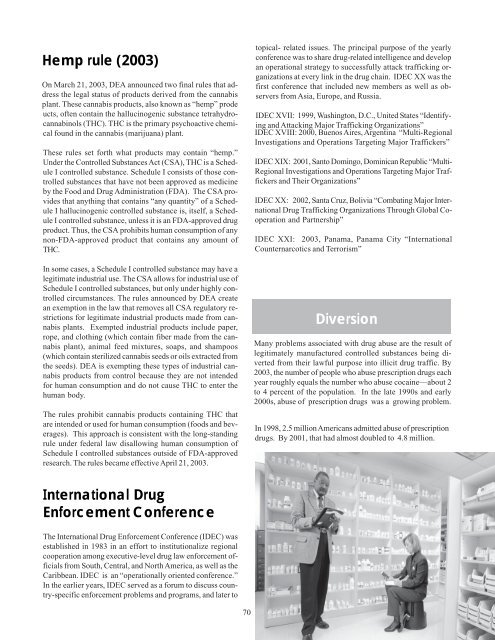Download This File - The Free Information Society
Download This File - The Free Information Society
Download This File - The Free Information Society
Create successful ePaper yourself
Turn your PDF publications into a flip-book with our unique Google optimized e-Paper software.
Hemp rule (2003)<br />
On March 21, 2003, DEA announced two final rules that address<br />
the legal status of products derived from the cannabis<br />
plant. <strong>The</strong>se cannabis products, also known as “hemp” prode<br />
ucts, often contain the hallucinogenic substance tetrahydrocannabinols<br />
(THC). THC is the primary psychoactive chemical<br />
found in the cannabis (marijuana) plant.<br />
<strong>The</strong>se rules set forth what products may contain “hemp.”<br />
Under the Controlled Substances Act (CSA), THC is a Schedule<br />
I controlled substance. Schedule I consists of those controlled<br />
substances that have not been approved as medicine<br />
by the Food and Drug Administration (FDA). <strong>The</strong> CSA provides<br />
that anything that contains “any quantity” of a Schedule<br />
I hallucinogenic controlled substance is, itself, a Schedule<br />
I controlled substance, unless it is an FDA-approved drug<br />
product. Thus, the CSA prohibits human consumption of any<br />
non-FDA-approved product that contains any amount of<br />
THC.<br />
In some cases, a Schedule I controlled substance may have a<br />
legitimate industrial use. <strong>The</strong> CSA allows for industrial use of<br />
Schedule I controlled substances, but only under highly controlled<br />
circumstances. <strong>The</strong> rules announced by DEA create<br />
an exemption in the law that removes all CSA regulatory restrictions<br />
for legitimate industrial products made from cannabis<br />
plants. Exempted industrial products include paper,<br />
rope, and clothing (which contain fiber made from the cannabis<br />
plant), animal feed mixtures, soaps, and shampoos<br />
(which contain sterilized cannabis seeds or oils extracted from<br />
the seeds). DEA is exempting these types of industrial cannabis<br />
products from control because they are not intended<br />
for human consumption and do not cause THC to enter the<br />
human body.<br />
<strong>The</strong> rules prohibit cannabis products containing THC that<br />
are intended or used for human consumption (foods and beverages).<br />
<strong>This</strong> approach is consistent with the long-standing<br />
rule under federal law disallowing human consumption of<br />
Schedule I controlled substances outside of FDA-approved<br />
research. <strong>The</strong> rules became effective April 21, 2003.<br />
International Drug<br />
Enforcement Conference<br />
<strong>The</strong> International Drug Enforcement Conference (IDEC) was<br />
established in 1983 in an effort to institutionalize regional<br />
cooperation among executive-level drug law enforcement officials<br />
from South, Central, and North America, as well as the<br />
Caribbean. IDEC is an “operationally oriented conference.”<br />
In the earlier years, IDEC served as a forum to discuss country-specific<br />
enforcement problems and programs, and later to<br />
70<br />
topical- related issues. <strong>The</strong> principal purpose of the yearly<br />
conference was to share drug-related intelligence and develop<br />
an operational strategy to successfully attack trafficking organizations<br />
at every link in the drug chain. IDEC XX was the<br />
first conference that included new members as well as observers<br />
from Asia, Europe, and Russia.<br />
IDEC XVII: 1999, Washington, D.C., United States “Identifying<br />
and Attacking Major Trafficking Organizations”<br />
IDEC XVIII: 2000, Buenos Aires, Argentina “Multi-Regional<br />
Investigations and Operations Targeting Major Traffickers”<br />
IDEC XIX: 2001, Santo Domingo, Dominican Republic “Multi-<br />
Regional Investigations and Operations Targeting Major Traffickers<br />
and <strong>The</strong>ir Organizations”<br />
IDEC XX: 2002, Santa Cruz, Bolivia “Combating Major International<br />
Drug Trafficking Organizations Through Global Cooperation<br />
and Partnership”<br />
IDEC XXI: 2003, Panama, Panama City “International<br />
Counternarcotics and Terrorism”<br />
Diversion<br />
Many problems associated with drug abuse are the result of<br />
legitimately manufactured controlled substances being diverted<br />
from their lawful purpose into illicit drug traffic. By<br />
2003, the number of people who abuse prescription drugs each<br />
year roughly equals the number who abuse cocaine—about 2<br />
to 4 percent of the population. In the late 1990s and early<br />
2000s, abuse of prescription drugs was a growing problem.<br />
In 1998, 2.5 million Americans admitted abuse of prescription<br />
drugs. By 2001, that had almost doubled to 4.8 million.

















